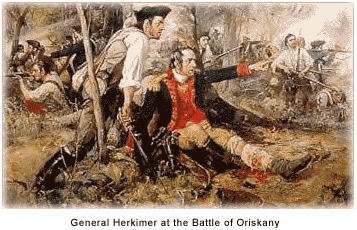As part of the British war plan of 1777, Lieutenant Colonel Barry St. Leger led his army eastward across the Mohawk Valley toward Albany. One early order of business was to take what he believed would be lightly defended Fort Stanwix, which is today Rome, New York. Instead, St. Leger found a rebuilt and well-garrisoned installation, called Fort Schuyler by the Americans. His initial demand for surrender in early August was rebuffed by the defenders.
 Meanwhile, an American relief force was dispatched from nearby Fort Dayton with 800 militia soldiers under the command of Brigadier General Nicholas Herkimer. He approached cautiously and attempted to coordinate a strike against St. Leger with soldiers in Fort Schuyler; that effort failed to materialize and Herkimer was goaded into precipitous action by his men.
On August 6, the American relief column descended onto a narrow path in a ravine near Oriskany Creek. A 1,200-man detachment from St. Leger’s army, mostly Mohawks and Loyalists, was lying in wait. The initial volley cut down most of the American leadership, including Herkimer who sustained a serious leg wound. He had his men prop him up against a tree and continued to direct the battle. Despite his efforts, the Americans were eventually forced from the field.
Both sides suffered heavy losses at Oriskany. Herkimer was taken back to his home where his leg was amputated. He died shortly thereafter. Most of his surviving militiamen returned to their homes, which allowed the British to concentrate again on Fort Schuyler.
What appeared to be a success for St. Leger was only temporary. He continued his siege for another two weeks, but then concluded that he was no match for Benedict Arnold's advancing forces and returned to Fort Oswego. The British army in the Mohawk Valley failed to keep its rendezvous with Burgoyne at Albany, a failure that contributed heavily to the events around Saratoga in the following weeks.
Meanwhile, an American relief force was dispatched from nearby Fort Dayton with 800 militia soldiers under the command of Brigadier General Nicholas Herkimer. He approached cautiously and attempted to coordinate a strike against St. Leger with soldiers in Fort Schuyler; that effort failed to materialize and Herkimer was goaded into precipitous action by his men.
On August 6, the American relief column descended onto a narrow path in a ravine near Oriskany Creek. A 1,200-man detachment from St. Leger’s army, mostly Mohawks and Loyalists, was lying in wait. The initial volley cut down most of the American leadership, including Herkimer who sustained a serious leg wound. He had his men prop him up against a tree and continued to direct the battle. Despite his efforts, the Americans were eventually forced from the field.
Both sides suffered heavy losses at Oriskany. Herkimer was taken back to his home where his leg was amputated. He died shortly thereafter. Most of his surviving militiamen returned to their homes, which allowed the British to concentrate again on Fort Schuyler.
What appeared to be a success for St. Leger was only temporary. He continued his siege for another two weeks, but then concluded that he was no match for Benedict Arnold's advancing forces and returned to Fort Oswego. The British army in the Mohawk Valley failed to keep its rendezvous with Burgoyne at Albany, a failure that contributed heavily to the events around Saratoga in the following weeks.